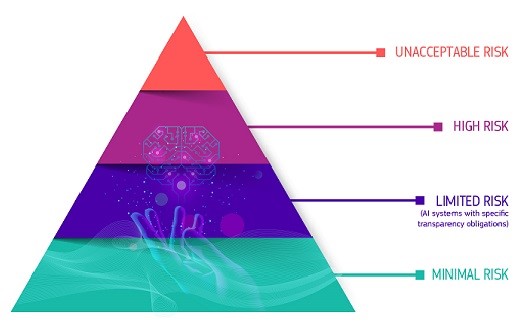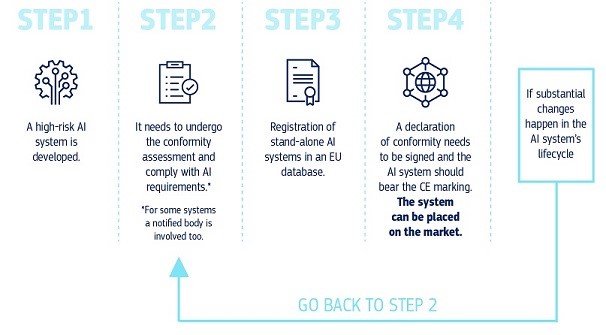Why do we need rules on AI?
The proposed AI regulation ensures that Europeans can trust what AI has to offer. While most AI systems pose limited to no risk and can be used to solve many societal challenges, certain AI systems create risks that need to be addressed to avoid undesirable outcomes.
For example, it is often not possible to find out why an AI system has made a decision or prediction and reached a certain outcome. So, it may become difficult to assess whether someone has been unfairly disadvantaged, such as in a hiring decision or in an application for a public benefit scheme.
Although existing legislation provides some protection, it is insufficient to address the specific challenges AI systems may bring.
The proposed rules will:
- address risks specifically created by AI applications
- propose a list of high-risk applications
- set clear requirements for AI systems for high risk applications
- define specific obligations for AI users and providers of high risk applications
- propose a conformity assessment before the AI system is put into service or placed on the market
- propose enforcement after such an AI system is placed in the market
- propose a governance structure at European and national level
A risk-based approach

Unacceptable risk: All AI systems considered a clear threat to the safety, livelihoods and rights of people will be banned, from social scoring by governments to toys using voice assistance that encourages dangerous behaviour.
High-risk: AI systems identified as high-risk include AI technology used in:
- Critical infrastructures (e.g. transport), that could put the life and health of citizens at risk;
- Educational or vocational training, that may determine the access to education and professional course of someone’s life (e.g. scoring of exams);
- Safety components of products (e.g. AI application in robot-assisted surgery);
- Employment, workers management and access to self-employment (e.g. CV-sorting software for recruitment procedures);
- Essential private and public services (e.g. credit scoring denying citizens opportunity to obtain a loan);
- Law enforcement that may interfere with people’s fundamental rights (e.g. evaluation of the reliability of evidence);
- Migration, asylum and border control management (e.g. verification of authenticity of travel documents);
- Administration of justice and democratic processes (e.g. applying the law to a concrete set of facts).
High-risk AI systems will be subject to strict obligations before they can be put on the market:
- Adequate risk assessment and mitigation systems;
- High quality of the datasets feeding the system to minimise risks and discriminatory outcomes;
- Logging of activity to ensure traceability of results
- Detailed documentation providing all information necessary on the system and its purpose for authorities to assess its compliance;
- Clear and adequate information to the user;
- Appropriate human oversight measures to minimise risk;
- High level of robustness, security and accuracy.
In particular, all remote biometric identification systems are considered high risk and subject to strict requirements. Their live use in publicly accessible spaces for law enforcement purposes is prohibited in principle. Narrow exceptions are strictly defined and regulated (such as where strictly necessary to search for a missing child, to prevent a specific and imminent terrorist threat or to detect, locate, identify or prosecute a perpetrator or suspect of a serious criminal offence). Such use is subject to authorisation by a judicial or other independent body and to appropriate limits in time, geographic reach and the data bases searched.
Limited risk, i.e. AI systems with specific transparency obligations: When using AI systems such as chatbots, users should be aware that they are interacting with a machine so they can take an informed decision to continue or step back.
Minimal risk: The proposal allows the free use of applications such as AI-enabled video games or spam filters. The vast majority of AI systems currently used in the EU fall into this category, where they represent minimal or no risk.

How does it all work in practice for providers of high risk AI systems?
Once the AI system is on the market, authorities are in charge of the market surveillance, users ensure human oversight and monitoring, and providers have a post-market monitoring system in place. Providers and users will also report serious incidents and malfunctioning.
Future-proof legislation
As AI is a fast evolving technology, the proposal is based on a future-proof approach, allowing rules to adapt to technological change. AI applications should remain trustworthy even after they have been placed on the market. This requires ongoing quality and risk management by providers.
Next steps
Following the Commission’s proposal in April 2021, the regulation could enter into force in the second half of 2022 in a transitional period. In this period, standards would be mandated and developed, and the governance structures set up would be operational. The second half of 2024 is the earliest time the regulation could become applicable to operators with the standards ready and the first conformity assessments carried out.
(Source: European Commission)
Download Proposal